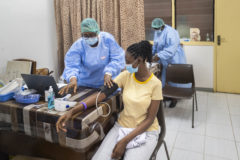Nasdaq-listed Swedish healthtech firm Olink has announced that D-CYPHR, the regional proteomic facility in Cape Town, South Africa, has adopted Olink technology for tuberculosis research and other diseases.
The facility became the first service provider to launch Olink® Target 96, Target 48, and Olink® Flex platforms. These will be used for targeted protein biomarker discovery on the African continent.
Proteomics refers to the study of the interactions, functions, compositions, and structures of proteins and their cellular activities. Olink claims to offer “an unmatched high-multiplex technique to identify actionable biomarkers, with a strong focus on the human plasma proteome.”
D-CYPHR is a new facility co-founded by the Centre for Proteomic and Genomic Research (CPGR) and the Institute of Infectious Disease and Molecular Medicine (IDM). It falls under the DIPLOMICS network programme. This is an initiative of the South African Department of Science and Innovation (DSI).
D-CYPHR enables access to proteomics and metabolomics technologies and expertise. It supports complex clinical and biological research that is not possible elsewhere in this region.
“One of the objectives of the DIPLOMICS programme is to enable and improve access to high-calibre ‘omics technologies and expertise. Through the D-CYPHR laboratory, we are excited about the introduction of the Olink technology, which will dramatically improve the quality and throughput of advanced proteomics research in South Africa,” said Dr Tim Newman, Program Manager for DIPLOMICS.
According to a statement by the firm, among the first projects to use Olink® Target 96 and Target 48 will be those directed toward COVID-19 and tuberculosis research. The Olink panels for targeted protein biomarker discovery enable faster, better-informed decisions in human protein biomarker research by providing high-multiplex immunoassays that do not compromise on either data quality or performance.
Recent research shows that tuberculosis is a serious public health issue in South Africa, with about 450,000 people developing the disease every year. It is also South Africa’s leading cause of death, killing about 89,000 every year, an average of ten people every hour.
“The ability to quantify large panels of secreted and cell surface antigens in clinical samples from tuberculosis patients using high throughput, multiplexed Olink® assays should enable new insights to be gained regarding immunopathogenesis in this important infectious disease,” added Professor Jonathan Blackburn, Deputy Director of the IDM.




















